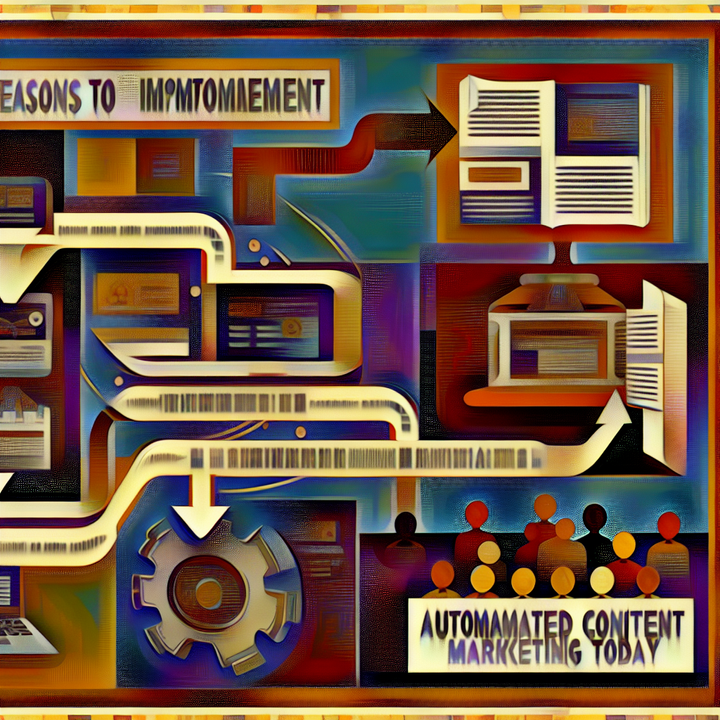Maximizing ROI with Automated Blog Services

Understanding the Fundamentals of ROI in Content Marketing
Return on Investment (ROI) is a critical metric in the realm of content marketing, serving as a cornerstone for measuring the success and efficiency of marketing strategies. ROI quantifies the financial return generated from the resources invested in content marketing activities, thereby enabling businesses to gauge the effectiveness of their marketing efforts.
In essence, ROI is calculated by dividing the net profit from content marketing activities by the total investment in those activities. This can be expressed with the formula:
ROI = (Net Profit / Total Investment) x 100
For businesses, understanding and optimizing ROI in content marketing is fundamental. It provides insights into which activities are generating the most value, allowing for data-driven decisions and more efficient allocation of resources. The higher the ROI, the more successful the content marketing initiative is considered to be.
Measuring ROI also highlights areas where improvements can be made, such as enhancing the quality of content, refining SEO strategies, or investing more in distribution channels that yield the highest returns. It's not just about generating traffic but converting that traffic into leads and ultimately, loyal customers.
The Challenges of Manual Blog Management for Modern Businesses
Managing blogs manually presents a plethora of challenges for various business stakeholders, ranging from small business owners to marketing managers, content strategists, and startup founders. Some of the common hurdles include:
- Time Constraints: Crafting high-quality content consistently requires a significant time investment. Many businesses struggle to find the time needed to research, write, edit, and optimize blog posts.
- Resource Limitations: Smaller teams often lack the dedicated resources or expertise required for effective blog management. This can lead to inconsistent posting schedules and varied content quality.
- Maintaining Quality: Ensuring that every piece of content meets high standards for readability, engagement, and SEO is a daunting task. Consistency in quality is vital for building a loyal audience.
- SEO Challenges: Implementing and keeping up-to-date with SEO best practices is a continuous process. This includes keyword research, on-page SEO, backlinking, and technical SEO, which can be overwhelming without specialized knowledge.
These challenges often result in suboptimal blog performance, affecting website traffic, user engagement, and lead generation efforts.
How Automated Blog Services Work
Automated blog services leverage advanced technology to streamline the process of content creation and distribution, effectively alleviating the challenges of manual blog management. Here’s a step-by-step overview of how these services typically operate:
- Profile Customization: The service begins by understanding the business’s profile, industry, and target audience. This sets the foundation for generating relevant and engaging content.
- Content Creation: Using AI and machine learning algorithms, the service generates blog posts tailored to the business's profile. This includes keyword research, topic selection, drafting, and initial editing.
- SEO Optimization: Automated tools ensure that the content is SEO-optimized by including relevant keywords, meta descriptions, alt tags, and internal linking structures.
- Content Review: While automation covers the bulk of the work, human editors review the drafts to ensure quality, coherence, and alignment with the brand’s voice.
- Scheduling and Publishing: The service handles the scheduling and publishing of posts, maintaining a consistent posting schedule to enhance engagement and SEO performance.
- Performance Analytics: Post-publication, the service tracks and analyzes the performance of the blog posts, providing insights and metrics to aid in future content strategies.
This holistic approach not only saves time and resources but also ensures that the content is of high quality and well-optimized for search engines.
Practical Benefits of Automating Your Blog
Implementing an automated blog service can revolutionize how businesses handle content marketing. Here are some of the significant benefits for different target personas:
- Time Efficiency: Automation significantly reduces the time required for content creation and management, allowing stakeholders to focus on strategic tasks.
- Cost-Effectiveness: By streamlining processes, businesses can reduce the expenses associated with hiring multiple content creators and SEO specialists.
- Improved SEO: Automated services ensure that blogs are consistently optimized for search engines, improving visibility and driving more organic traffic to the website.
- Consistency and Quality: Automation helps maintain a consistent posting schedule and ensures that all content adheres to high-quality standards, enhancing reader engagement and trust.
Case Study: Successful Implementation of Automated Blog Services
To illustrate the effectiveness of automated blog services, let’s examine a case study of ABC Corp, a mid-sized B2B company that successfully integrated an automated blog service.
Prior to automation, ABC Corp faced typical challenges such as inconsistent posting schedules, variable content quality, and subpar SEO performance. By adopting an automated blog service, they were able to transform their content marketing efforts.
| Metric | Before Automation | After Automation |
|---|---|---|
| Monthly Blog Posts | 4 | 12 |
| Website Traffic | 5,000 visits | 15,000 visits |
| Lead Conversion Rate | 1% | 3% |
Moreover, the marketing manager at ABC Corp noted:
"The automated blog service not only saved us countless hours but also tripled our website traffic and significantly improved our lead conversion rate."
Steps to Integrate Automated Blog Services into Your Business
Integrating automated blog services seamlessly into your existing processes involves several key steps:
- Identify Your Goals: Determine what you aim to achieve with automated content, such as increasing website traffic, improving lead conversion, or enhancing brand awareness.
- Choose the Right Service: Research and select an automated blog service that aligns with your business needs and objectives.
- Initial Setup: Work with the service provider to set up your profile, define your target audience, and establish content guidelines.
- Content Calendar: Develop a content calendar that outlines the posting schedule, key topics, and important dates.
- Monitor and Adjust: Use analytics tools to track the performance of your blog content, and make necessary adjustments to optimize results.
Measuring the ROI of Your Automated Blog Activities
Accurately measuring the ROI of automated blog activities is crucial for assessing their effectiveness. Here are some methods and metrics to consider:
- Key Performance Indicators (KPIs): Identify KPIs such as website traffic, engagement rates, lead conversion rates, and customer acquisition costs.
- Performance Tracking Tools: Utilize tools like Google Analytics, SEMrush, and HubSpot to monitor your blog’s performance and gather data-driven insights.
- Data Analysis Techniques: Analyze the collected data to identify trends, measure the impact of specific blog posts, and understand the audience's behavior.
Regularly reviewing these metrics allows you to refine your content strategy and maximize your ROI.
Common Pitfalls and How to Avoid Them
While automated blog services offer numerous benefits, there are common pitfalls to be aware of:
- Over-Reliance on Automation: Complete dependence on automation can lead to a lack of personalized touch in your content. It's essential to balance automation with human oversight.
- Lack of Consistency: Inconsistent application of SEO practices or content review processes can diminish the quality and performance of your blog.
- Incorrect Metrics: Focusing on the wrong performance metrics can lead to misguided strategies. It's important to track metrics that align with your business goals.
Aware of these pitfalls, businesses can better navigate the automation process and optimize their content marketing efforts effectively.
Maximizing ROI with Tailored Content Strategies
Customized content strategies greatly enhance the ROI of automated blog services. Aligning content with the company’s profile, industry, and target audience ensures greater relevance and engagement. Here are some tips for developing a tailored content plan:
- Deep Audience Understanding: Invest time in understanding your target audience's preferences, pain points, and behavior.
- Edit + Align Content: Customize automated content to reflect your brand's voice and message. Ensure each piece is relevant to your target audience.
- Regular Feedback Loops: Continuously gather feedback from your audience and use it to refine your content strategy.
Such personalized approaches can significantly boost engagement rates and lead conversion metrics.
Future Trends in Automated Content Marketing
The field of automated content marketing is ever-evolving, with several emerging trends poised to shape its future. Here are some predictions:
- Advanced AI Capabilities: Continued advancements in AI and machine learning will enable even more sophisticated content creation and personalization.
- Voice Search Optimization: As voice search becomes more prevalent, optimizing content for voice-based queries will be essential.
- Integrative Platforms: Future tools might offer more integrated solutions, combining content creation, SEO, distribution, and analytics in a single platform.
- Increased Focus on Video Content: Automated creation of video content, a medium that continues to gain popularity, will likely become commonplace.
Staying ahead of these trends will ensure that businesses can leverage the full potential of automated content marketing technologies.
As businesses continue to navigate the digital landscape, the automation of blog services offers a powerful means to enhance content marketing efforts—elevating ROI, improving SEO, and driving more meaningful engagement with audiences. Embracing these advancements wisely ensures not just survival, but thriving in the competitive marketspace.



